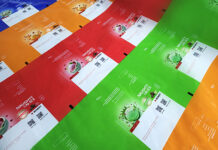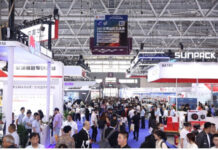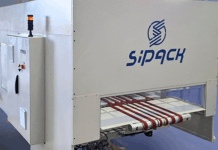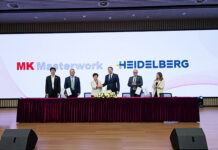On July 2, the official inauguration of the new SOMA Experience Center was held in Carmignano di Brenta (PD), with the participation of around 180 professionals, including printers, converters, and technology suppliers. It was a moment of dialogue, discovery, and sharing, strongly promoted by the Czech company to strengthen its presence in Italy and create a technological reference hub for the whole of Europe
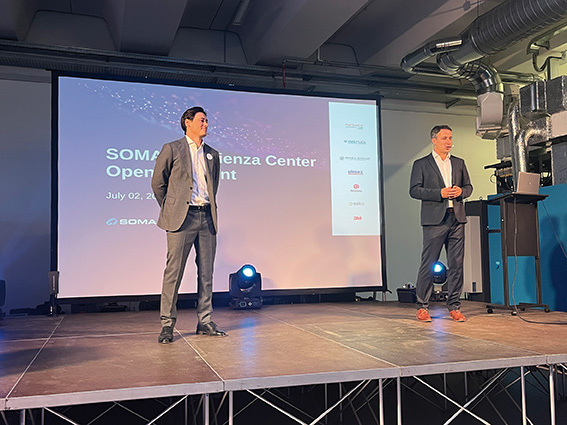
For SOMA, a physical presence in the Italian market has been a priority. The company initially set up a lean but effective commercial and organizational structure, with key figures directly connected to the market. This was followed by the first sales and installations, leading up to the recent announcements that paved the way for the inauguration of the new SOMA Experience Center on July 2 in Carmignano di Brenta, Padua province. The new center is a modern and multifunctional space designed to host customers and partners for live demos, training programs, testing, and the joint development of innovative solutions for the flexo printing of the future.
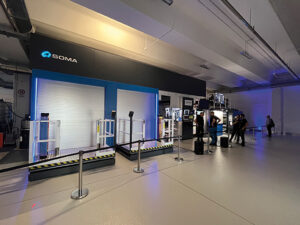 To further consolidate its position, SOMA has recently established SOMA Italia, led by CEO Moreno Melegatti, who brings extensive experience from SOMA’s headquarters. In addition to strengthening commercial operations, the new branch ensures customers benefit from local service support headed by Gianluca Quartieri thanks to his more than 25 years of experience in the converting industry. This structure enables SOMA to respond faster and more effectively to the needs of the Italian flexo market, building closer relationships with printers and converters.
To further consolidate its position, SOMA has recently established SOMA Italia, led by CEO Moreno Melegatti, who brings extensive experience from SOMA’s headquarters. In addition to strengthening commercial operations, the new branch ensures customers benefit from local service support headed by Gianluca Quartieri thanks to his more than 25 years of experience in the converting industry. This structure enables SOMA to respond faster and more effectively to the needs of the Italian flexo market, building closer relationships with printers and converters.
Sustainable automation made in SOMA
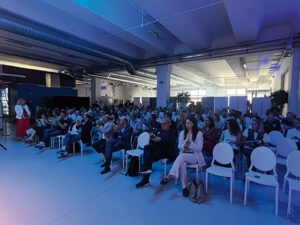 The event was opened by Matteo Melegatti, SOMA’s Sales Manager for Italy, and Petr Blasko, Marketing Director, who presented the strategic concept behind the company’s vision: sustainable automation.
The event was opened by Matteo Melegatti, SOMA’s Sales Manager for Italy, and Petr Blasko, Marketing Director, who presented the strategic concept behind the company’s vision: sustainable automation.
This operational model aims to combine productivity, quality, and environmental responsibility, in line with the new demands of the packaging industry. According to SOMA, automation does not just reduce downtime and human error, it also helps minimize waste, energy consumption, and material usage, while at the same time increasing process stability and print consistency.
Optima² 8+2 and IPU module: cutting-edge flexography
The star of the day was the Optima² 8+2, a state-of-the-art flexographic press configured with eight printing units and two special units.
Of particular interest to operators was the new IPU – Intelligent Printing Unit module, which allows inks, varnishes, or coatings to be managed in a single pass.
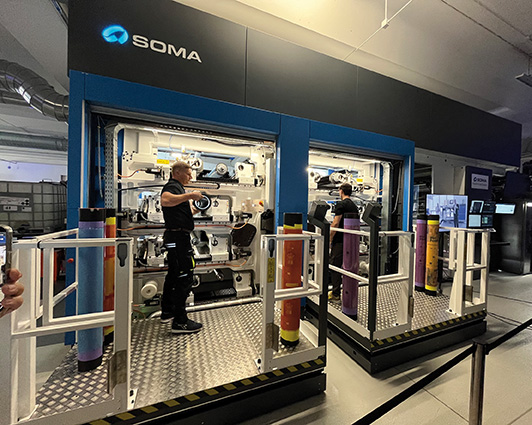
The Optima² installed in the Experience Center also stands out for its rigid singleblock cast-iron frame, which supports the Advanced Bounce Control technology designed to minimize the disruptive bouncing effect at high printing speeds. Key innovations include Drive Tuning, which automatically adjusts the motors to the type of job to print, and iDry, which adapts optimizes drying output.
Another strength of this flexo press is the intelligent management of anilox rollers, with tracking of parameters (line count and volume). In partnership with Ulmex, SOMA also showcased the innovative Evolux washing system, equipped with an in-line 3D microscope that can map and store each anilox, transferring data directly to the RFID chip in the anilox.
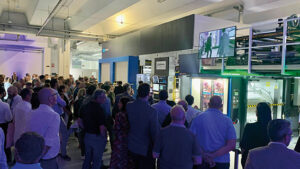 Finally, among the most significant innovations is the Ink Cartridge system, which enables printing with just minimum amount of ink. This solution is particularly well-suited for costly metallic inks or Pantone colors, reducing both waste and machine setup times.
Finally, among the most significant innovations is the Ink Cartridge system, which enables printing with just minimum amount of ink. This solution is particularly well-suited for costly metallic inks or Pantone colors, reducing both waste and machine setup times.
Live demonstration: automated job change and printing without black
During the demo, guests witnessed an extremely fast automated job change, with plate mounting, data transfer, and setup completed in just a few minutes. Thanks to microchips integrated into the sleeves, the press was able to automatically receive all prepress information and independently configure processing parameters. The production can be overseen via a cloud platform, and with the Supervision software it is possible to monitor consumption in real time
Two pet food packages were printed live, both featuring dog subjects: the first using a water-based matte varnish in register thanks to the IPU, and the second without the use of black ink, a sustainable choice that demonstrated how it is possible to achieve excellent photographic quality while reducing environmental impact.
The result impressed the audience with its color accuracy, detail definition, and brilliance of tones.
Partners in dialogue: the round table on flexo challenges
The event concluded with a high-level technical and strategic round table, moderated by SOMA, featuring seven key partners from the flexographic supply chain. Each brought a concrete vision of the challenges and opportunities facing the industry.
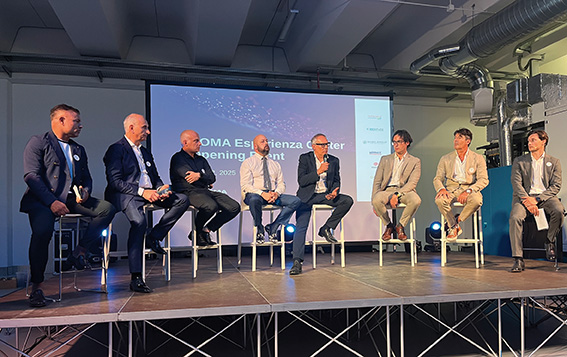
Nicola Battaglia (Poligrafica Veneta) highlighted the growing demand for quality and standardization, especially in high-definition printing. “Our clients demand extremely high quality but with ever shorter runs. Standardizing processes is essential to guarantee consistent results. As for sustainability, it must be real and measurable but also economically viable”, he stated from his perspective as a converter who deals daily with brand owners’ requirements.
Enzo Consalvo (Inci-Flex) emphasized the importance of advanced prepress, synergistic with printing technologies, to ensure color consistency and reduced turnaround times. His company, which provides both flexo plates and gravure cylinders, maintains a global, balanced perspective across both markets. As Enzo noted, digital printing in packaging is gaining ground, particularly for short runs and for product test launches prior to full market release.
Davide Meroni (Esko), speaking about advanced prepress (Esko supplied Inci-Flex with the world’s first Crystal Quartz) stressed the importance of prepress digitization and integrated data transfer. These elements now enable full traceability and workflow automation. “The common goal is to reduce time-to-market. Digital tools and collaborative workflows allow supply chain players to interact, accelerating project approval. And thanks to artificial intelligence, process optimization will gain further advantages”.
Mattia Fontani, PhD (Sun Chemical) underlined the crucial role of consumables, inks and varnishes, in developing sustainable and high-performance packaging, emphasizing the research into greener formulations. “Foam management, film adhesion, and anilox cleaning are critical aspects of the flexo printing process, but with proper GMPs and a properly configured press, excellent results can be achieved”.
Fabio Vincenzi (SIMEC Group) presented his company’s anilox solutions, stressing durability, precision, and control as key elements of quality. “At Simec, we dedicate obsessive attention starting from design. Engravings are coded for OEMs or specific customers, and we place great focus on simplified maintenance and regenerability”.
Angelo Maggi (Ulmex Italia), also on the topic of anilox but focusing on cleaning, presented the possibilities offered by inspection and cleaning systems. tools essential for maintaining high line efficiency and ensuring quality even in short runs.
The panel concluded with a very clear message: innovation cannot exist without collaboration, expertise, and environmental responsibility. Sustainable flexo is already a tangible reality, but it must be built and managed together.






